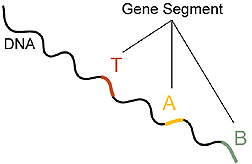
What is the relationship between DNA and genes? Genes are small segments of DNA along the linear strands shown in the figure below.

DNA in the FORM of Chromatin
Study behavioral objective 4 and read the pages indicated by G-3. The chromatin in the above figure consists of a long molecules of DNA continuous from end to end (linear), combined with proteins called histones. Along the length of this long DNA molecule are several segments which serve as genes. Examine the figure below.

DNA Molecule with Gene Segments
This figure shows a single strand of DNA with three genes or segments of the DNA (T, A, and B).
These genes function in the working cell by directing the synthesis of specific proteins which are converted into enzymes that in turn cause specific chemical reactions producing a phenotype. In the figure above gene "T" represents a gene that directs the synthesis of a specific protein which forms into an enzyme that causes a chemical reaction forming a particular phenotype (example red pigments in a rose flower). "A" represent a second gene that directs the synthesis of a second specific protein which forms into a different enzyme which causes a chemical reaction forming a second phenotype (example shape of rose petals). You may want to review proteins and enzymes in miniunits Alpha and Beta. Look up 'phenotype' in the glossary of the text. The exact mechanism of protein synthesis will be explained in miniunit Delta. In your notes draw a flow diagram showing the relationship between DNA, genes, proteins, enzymes, and phenotypes.
Click here to check your answer.
For information on how to use this page, go to How to Use This Site.Created by the Center for Learning Technologies, Academic Technology Services.
Last modified October 22, 1997.